Background
- Computer-assisted qualitative data analysis software (CAQDAS).
- Stores, indexes, and retrieves data.
- Content, discourse, and transcription analyses.
- Interpretation of texts, coding, application of grounded theory methodology, and recursive abstraction.
- Common features:
- Annotations, data visualization, media analytics,
- Mixed method research,
- Multi-language, qualitative comparative analyses, sentiment analysis,
- Statistical analysis and text analytics.
Computer-assisted qualitative data analysis software (CAQDAS) has revolutionized the way qualitative research is conducted in modern times. CAQDAS helps in the storing, indexing, and retrieving of qualitative data whether for academic or commercial purposes. The need for research has increased significantly over the years, which underscores the importance of having useful tools that could help researchers carry out reliable and valid studies effectively and within a short period. The CAQDAS system has a wide range of processes that could accommodate content, discourse, and transcription analyses, interpretation of texts, coding, the application of grounded theory methodology, and recursive abstraction (Sohn, 2017). The commonly used data types include focus groups, Internet, telephone, and e-mail interviews, nominal groups, face-to-face interviews, and document collation among other forms of qualitative data.
The common features of CAQDAS include annotations, data visualization, media analytics, mixed method research, multi-language, qualitative comparative analyses, sentiment analysis, statistical analysis, text analytics, and user research analysis. Before the invention of CAQDAS, researchers would use the traditional manual methods of data analysis, which are time-consuming and prone to errors due to the extensive need for human input (Silver & Lewins, 2014). However, with CAQDAS, researchers could now analyze huge amounts of data within a short time with desirable validity and credibility. Nevertheless, these software problems have some associated drawbacks such as distancing researchers from the data, thus negating the very essence of carrying out qualitative studies. More of such issues and other merits will be discussed later in the presentation.
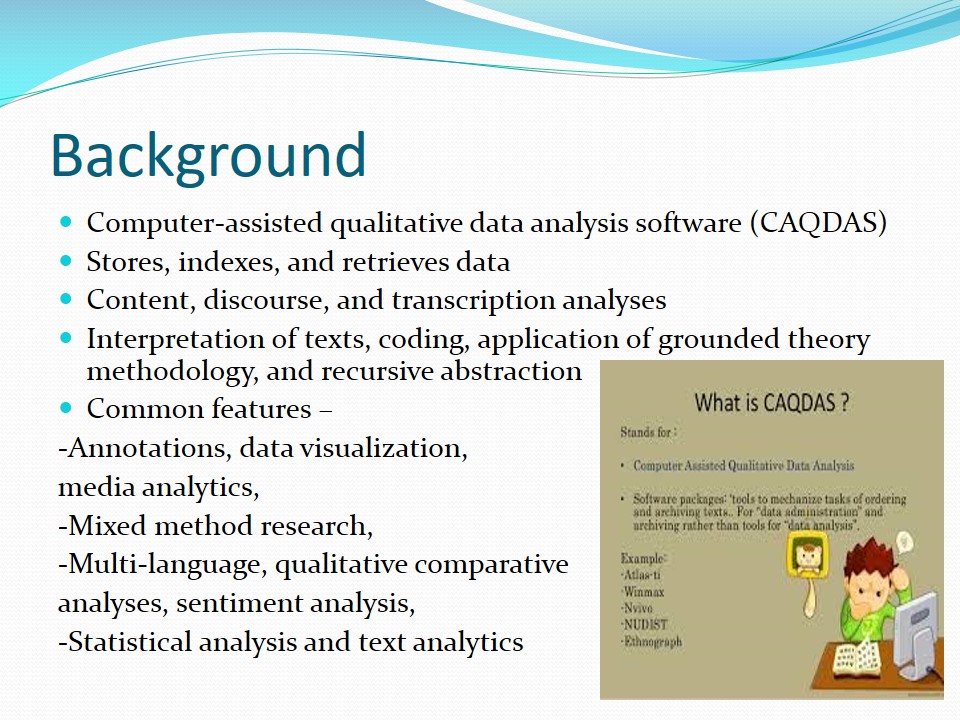
Software Program Description
- Atlas.ti – chosen for this project.
- Uncovers and analyzes composite phenomena in unstructured data.
- Main features, unicode throughout.
- Geodata integration.
- Text-to-media synchronization.
- Multi-document view & data importation.
The software program chosen for this project is Atlas.ti, which is developed by the ATLAS.ti Scientific Software Development GmbH. This dedicated qualitative analysis and proprietary software helps researchers to uncover and analyze composite phenomena in unstructured data. Using this software, researchers locate, code, and annotate study results in primary data with the aim of measuring and evaluating their relevance and understand the complex relationships among them. This software can be used in a wide range of study fields including, but not limited to, sociology, psychology educational sciences, criminology, communications, and economics. With Atlas.ti, researchers could appreciate details and see the larger picture at the same time. The software reveals relationships and meanings in primary data thus allowing researchers to ground their findings in the available information.
The main features of Atlas.ti include Unicode throughout, which allows for the coding of video, audio, image, and text materials. It has geodata integration capabilities and text-to-media synchronization. It allows users to compare data using its multi-document view features and integrative visualizations. Additionally, it can import data directly from Twitter, Endnote, and other platforms such as Evernote among others. It also has network groups and users could search for textual patterns using its object crawler feature. As such, different individuals working on the same project can use a single platform and integrate their information as the research progresses, which is time-saving and it offers a better way of making sense of data.
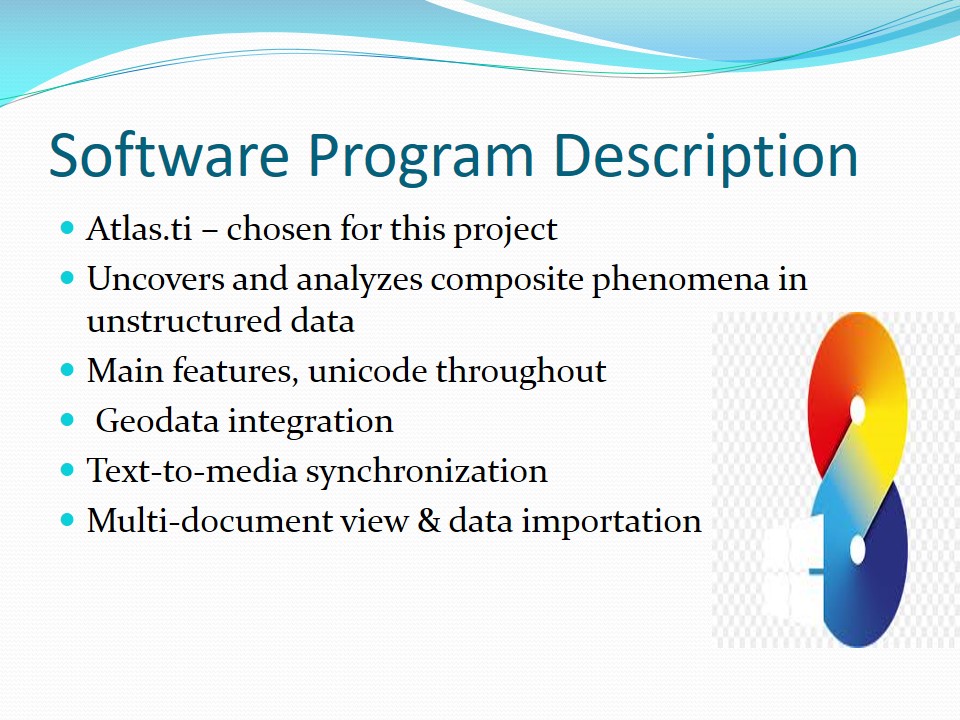
Advantages of CAQDAS
- Convenience and efficiency.
- Time-saving by eliminating manual tasks.
- Flexibility and thoroughness.
- Validity and rigor of research.
- Data examined rigorously and completely:
- Human errors avoided;
- New ways of data analysis;
- Researchers not limited by amount of data to be analyzed;
- Establishes relationship between data sets.
One of the many important advantages of CAQDAS is convenience and efficiency. According to Rahman (2016), CAQDAS allows researchers to save time that could be used in the tedious manual tasks, such as filling, refilling, copying, pasting, and cutting among other functionalities. Using CAQDAS, researchers could indicate boundaries of textual segments, search and assemble texts with similar codes, and attach information to texts. Additionally, users do not have to retype information when writing reports. As such, researchers create enough time to focus on data analysis because other clerical and manual tasks are performed using this software.
Another advantage is flexibility and thoroughness. CAQDAS is not limited by the number of codes that could be generated, thus providing greater complexity and flexibility when handling data. The number and size of transcripts that could be included in a research project are also not a limiting factor (Rahman, 2016). Additionally, users can change different aspects of their research including coding systems, add notes, and define different concepts even when the study has already started, hence the concept of flexibility. CAQDAS could also host different researchers working on the same project on a single platform. Finally, some advanced software allow researchers to attach analytical information about different data contexts, thus facilitating the development of new ideas. Ultimately, CAQDAS offers an advanced way of analyzing qualitative data to draw inferences and make sense of it, thus advancing knowledge and understanding of different complex phenomena.
CAQDAS supports the validity and rigor of research, which are important characteristics for reliable findings. Using this software, data is examined rigorously and completely, thus minimizing the chances of having errors caused by internal and external validity aspects (Maher, Hadfield, Hutchings, & de Eyto, 2018). In other words, all the available data related to a certain subject are examined. This feature allows researchers to avoid the human inclination to focus on data parts that fit their assumptions and preferences. In some software, researchers are allowed to examine their personal assumptions and different perspectives concerning a certain topic. Additionally, CAQDAS creates an audit trail of all analyzed data, thus allowing users to scrutinize the entire process, which ultimately improves credibility and validity. In some cases, when data is analyzed and presented for consumption, readers could question the validity of the methodologies used in the process. However, with CAQDAS, it is easy to track every step of the way and identify what happened at different sections of the study.
Finally, CAQDAS offer researchers with new ways of analyzing data. Normally, qualitative research is voluminous in nature, and thus without the assistance of software, researchers were limited to small data sets, which could be analyzed using simple strategies (Maher et al., 2018). As such, data collected would not be representative of a given phenomenon. However, with CAQDAS, researchers are not limited by the amount of data available for analysis. Besides, software establishes the relationship between data in ways that could not be humanly possible. In other words, using CAQDAS, researchers can make sense of data in a manner that could not be achieved using manual analysis.

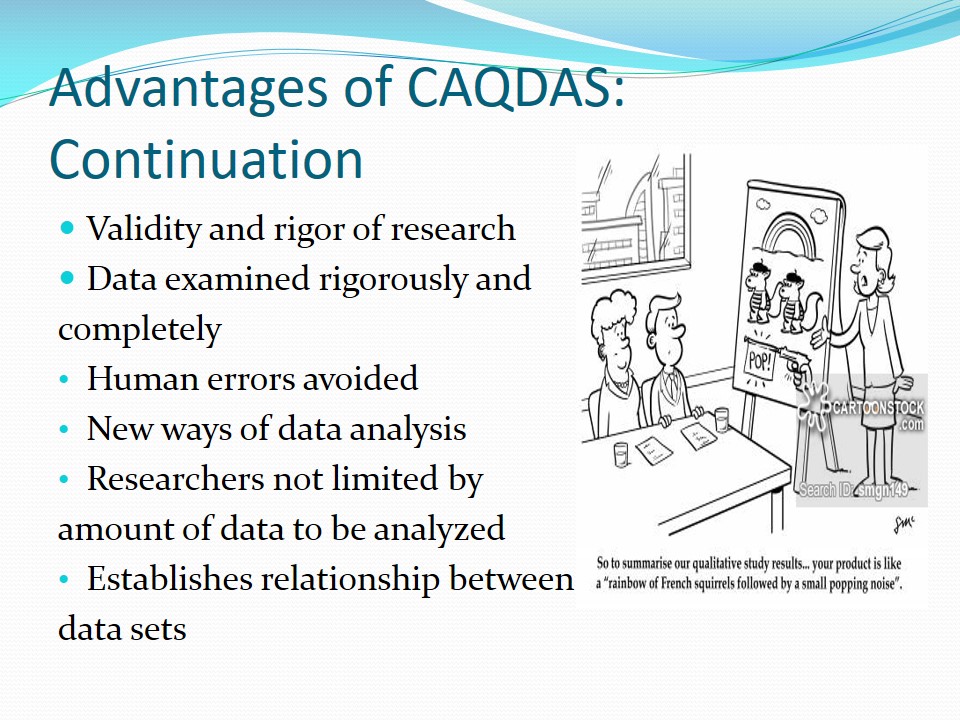
Disadvantages of CAQDAS
- Data quantity over data meaning.
- Homogenization of qualitative data analysis approaches.
- CAQDAS may drive questions.
- Data with breath but lacking depth.
- Negates the purpose of qualitative data.
- Privileging retrieval methods and codes.
- Users could favor certain code over others.
- Creates distance between the data and researchers.
- Leads to the loss of context and meaning.
- Dehumanized and sterile data.
One of the major concerns of using CAQDAS in qualitative research is shifting the focus from data meaning to quantity. With the emergence of such software, researchers are now under pressure to collect and analyze large amounts of data, which might affect the analytic process and ultimately the results. Having an enormous amount of data lined for analysis would not give researchers enough time to carry out sufficient and rigorous practices, which affects the meaning of data (Rahman, 2016). Consequently, CAQDAS has led to the availability of data findings with breadth, but lacking depth. This approach negates the purpose of qualitative research, which is to make sense of complex phenomena.
CAQDAS also lead to the homogenization of qualitative data analysis approaches. Using software, researchers could be compelled to look at data from a perspective that is not congruent with established methodological approaches. Before data can be analyzed, it has to be entered into the software being used. However, given the large volumes of data that have to be analyzed, researchers could be compelled to design questions that are compatible with the available software (Rahman, 2016). In this case, CAQDAS start driving questions, which is a reserved function of researchers, which ultimately affects the quality of results obtained from such studies. Additionally, the commercialization of CAQDAS may affect researchers’ capability to tell which software fits their specific studies because developers of these programs seek to make money. As such, they may exaggerate the capability of their software to mislead and convince users into buying, which affects the analytic procedure.
Another concern with the use of CAQDAS is the possibility of privileging retrieval methods and codes. The majority of these software work on the assumption that data analysis hinges on coding and retrieval. As such, users could be compelled to favor a certain code over others or data retrieval methods (Woods, Macklin, & Lewis, 2016). For instance, most software are developed using grounded theory, but not every researcher is interested in building theories. As such, care should be taken to avoid the contextualization of all data sets to avoid the overgeneralization of essence and meaning of data.
Additionally, the use of CAQDAS could create distance between the data and researchers, which might lead to the loss of context and meaning hence dehumanized and sterile data. The essence of qualitative research is to avoid the presence of such forms of data lacking the holistic imperative of qualitative methodologies. The major concern surrounding this issue is that pieces of coded data may be viewed as inflexible objects without desirable complexities such as tones, color, feelings, and sounds among other elements of richness (Woods et al., 2016). Besides, the coding language may assign different meanings to various data sets, thus robing contexts of meanings that body language and inflection diffuse on words. Making data inhumane is a real threat to qualitative research analysis, and CAQDAS seem to have this effect on data, and thus there is need for users to be keen when using these programs.
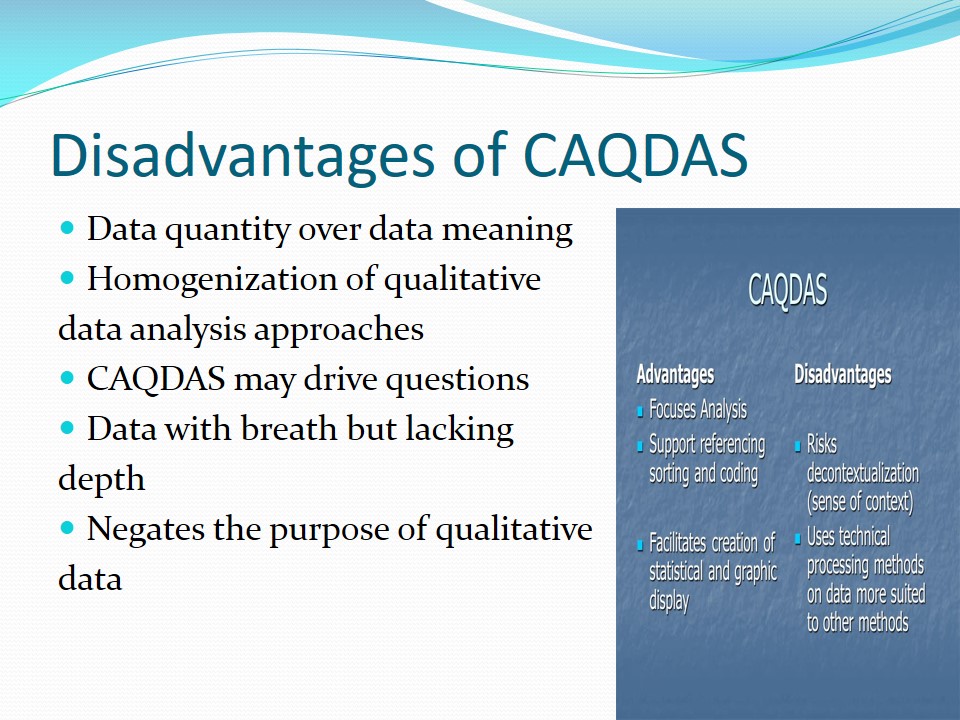
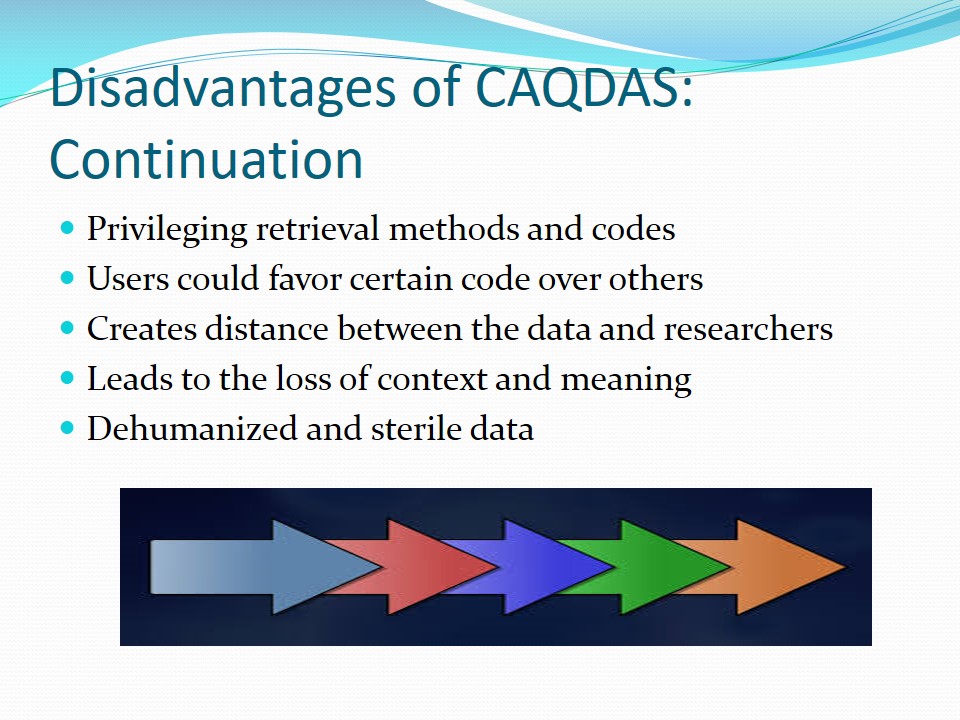
Merits of Atlas.ti
- Sophisticated – immediacy, visual, and spatial.
- VISE (visualization, integration, serendipity, and exploration) mode of operation.
- Operates in pictorial form.
- Supports text in different formats.
- Numerous built-in functions.
- Allows teamwork.
One of the strengths of this software is its sophistication in immediacy, visual, and spatial qualities. Using its VISE (visualization, integration, serendipity, and exploration) mode of operation, the software provides all aspects of data being analyzed on the screen at a go, thus allowing users to map out visual relationships and form links between different data sets. The software operates in spatial and medium with functions mostly organized in pictorial form. Additionally, the software is well-organized and with a simplified format, users can learn how to use it quickly. It also supports text in different formats such as PDF, graphical files, videos, and audios.
Atlas.ti has numerous built-in functions, which could be used for retrieving, coding, analyzing, exporting, and visualizing data. This software is highly responsive to the users’ suggestions and enquires, which is an added advantage to its interactive capacity. Additionally, Atlas.ti has many opportunities for users to train on how to use it through online and face-to-face opportunities. It also allows teams working on the same project to be hosted on a single platform. After learning how to use the software, it is easy to break down, reorganize, and regroup data sets thus allowing the user to maintain consistency in data handling. In summary, the software saves time and increases efficiency with which qualitative data could be analyzed together with improving validity and credibility of study findings.
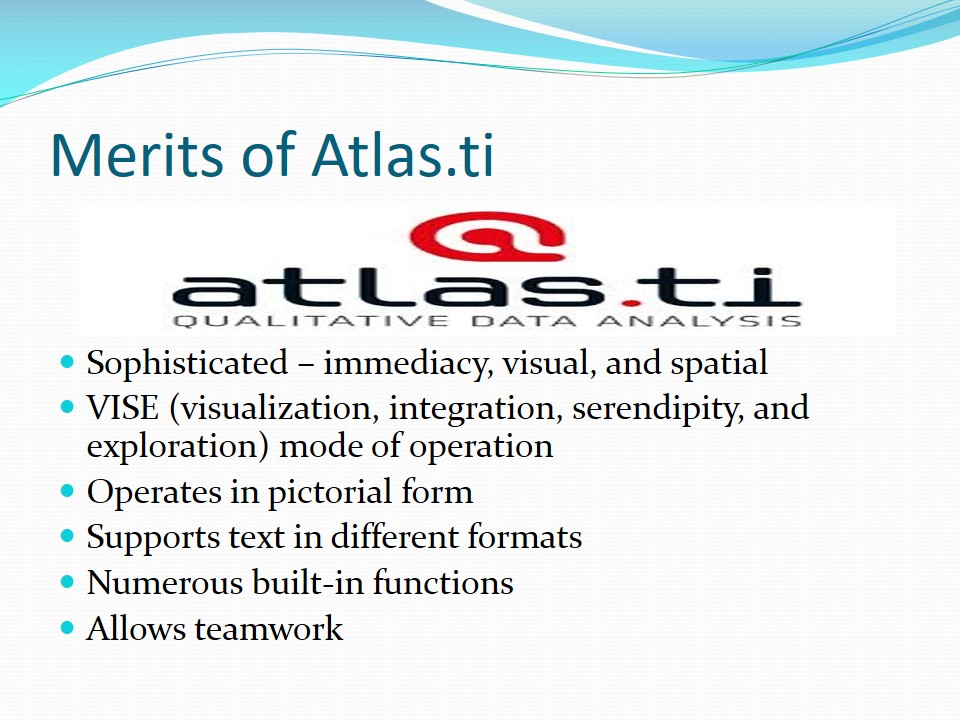
Drawbacks of Atlas.ti
- Proprietary software – costly.
- Prices for educational users range from $670 to $27,000.
- Majority of data sources are stored externally.
- Limited to “soft” data.
- A source of distraction for users.
Atlas.ti is proprietary software, which could be a limiting factor in its usage given the age of open source software platforms. Its pricing is structured as subscription and the current prices for educational users range from $670 to $27,000. However, this aspect might not be a problem for large learning institutions with the resources to purchase such software. Another drawback of this software is the use of unique coding systems that are not hierarchical visually. Additionally, the majority of data sources are stored externally as opposed to being found inside Atlas.ti hermeneutic unit. As such, users may waste time trying to keep track of the locations where original files are stored.
Moreover, Atlas.ti, like any other software, is limited to “soft” data. Therefore, if a user wants to analyze data in printed formats, such as printed books or reports, it means he or she has to be converted into softcopy first before being analyzed using the software. This process could be tedious and time-consuming. Other drawbacks are associated with the common issues linked to the use of CAQDAS in the analysis of qualitative data as discussed earlier. For instance, Atlas.ti could be a source of distraction for users, which might impede the process of thinking about data and comprehensive engagement of the researcher. In qualitative data analysis, it is important for researchers to interact closely with data for any meaningful sense-making, but this software might impede this process as data sets could be coded and generalized thus losing their richness.
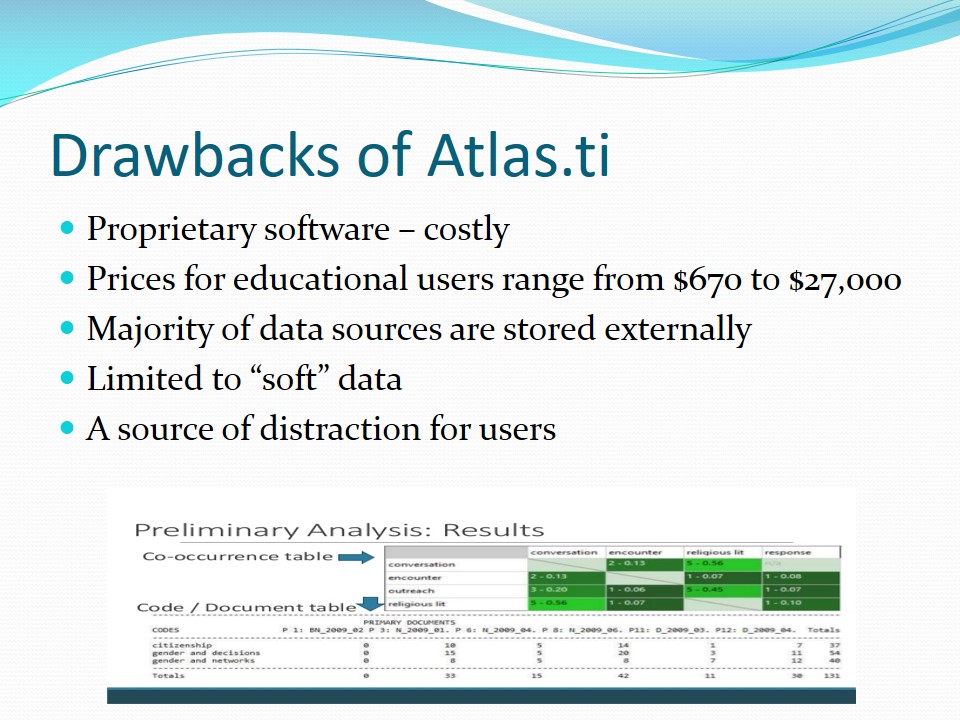
Advantages and Disadvantages of Manual Analysis
- Cheap;
- Increased oversight.
- Disadvantages:
- Tedious and time-consuming;
- Not suitable in modern times;
- Lacks flexibility and thoroughness;
- Lacks validity and credibility;
- Difficult to establish links between data sets.
The benefits of the manual analysis of qualitative data are limited. This form of data analysis does not require sophisticated and costly systems, and thus it is cheap. Additionally, manual methods ensure that researchers spend more time interacting with data, which increases oversight. However, the demerits of manual analysis are numerous; for instance, the process is tedious and time-consuming. Therefore, the amount of data that could be analyzed within a set time is limited (Silver & Lewins, 2014). This aspect affects the work that researchers can achieve especially during this era where the need for qualitative data analysis has increased significantly due to changing socio-economic and political dynamics.
As such, manual analysis does not offer the needed flexibility and thoroughness in analyzing qualitative data. For instance, once the process of data analysis has started, researchers cannot change it even with the emergence of new information because the process is tedious, but with CAQDAS, this goal could be achieved seamlessly (Silver & Lewins, 2014). Another problem with manual systems is the lack of validity and rigor of data. The extensive involvement of human subjects in this form of analysis exposes the process to errors, which ultimately affect the validity and credibility of the results. Finally, it is difficult for users to establish links and relationships between data sets using manual systems, which limit the scope of studies. In summary, manual data analysis has been overtaken by time especially for large institutions with enough resources to acquire useful programs that play a central role in the analysis of large volumes of data.
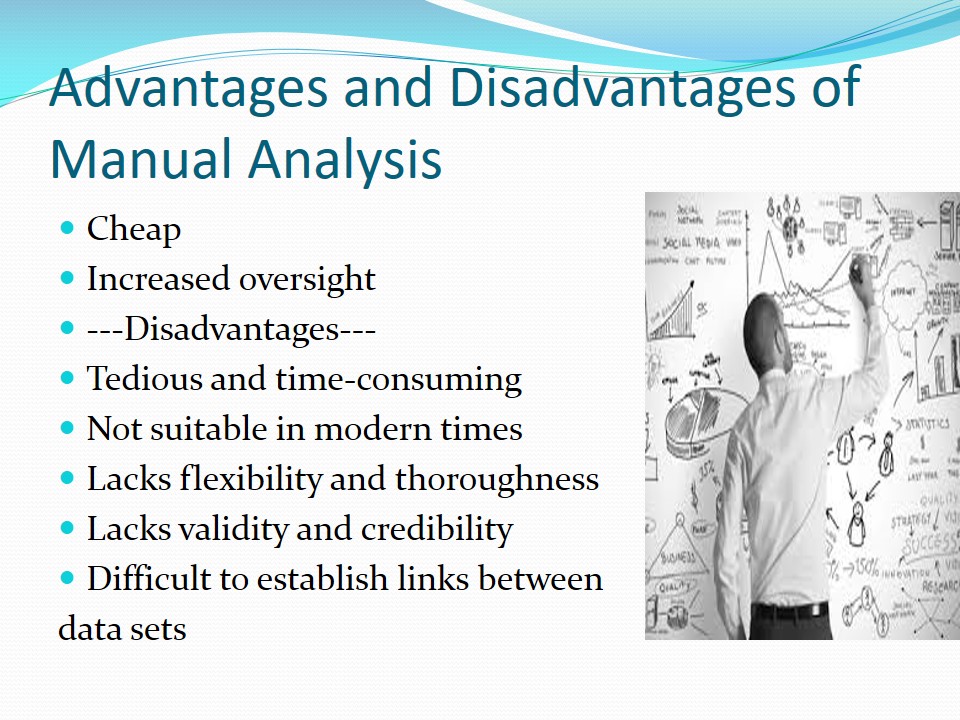
Recommendations
- Purchase Atlas.ti.
- Popular and easy-to-use.
- Improve data analysis and sense-making.
- Advance knowledge in the institution.
- Improve the institution’s public image.
- Associated few challenges could addressed.
I would recommend the dean to consider purchasing Atlas.ti as one of the popular and easy-to-use CAQDAS that are available in the market today. Researchers in the department cannot continue using manual analysis systems, which have been associated with numerous negative aspects especially in the current world where large volumes of qualitative data have to be analyzed within a short period. Despite the fact that this software is proprietary and thus expensive, it would save researchers invaluable time, which could be used in other productive activities, such as the real analysis of data and making sense of it to come up with novel and useful ideas for the institution and the society at large.
Having such as software will be a major benefit for this institution as it would advance knowledge by unlocking data due to exposure to modern data management and analysis for researchers and educators. The public image of the institution will also improve as potential learners will know that it is equipped with the requisite tools to enhance quality teaching and learning. The few challenges associated with this software will be addressed as they emerge. Besides, the company selling this software offers after-sale support services to facilitate learning on how to use the system.
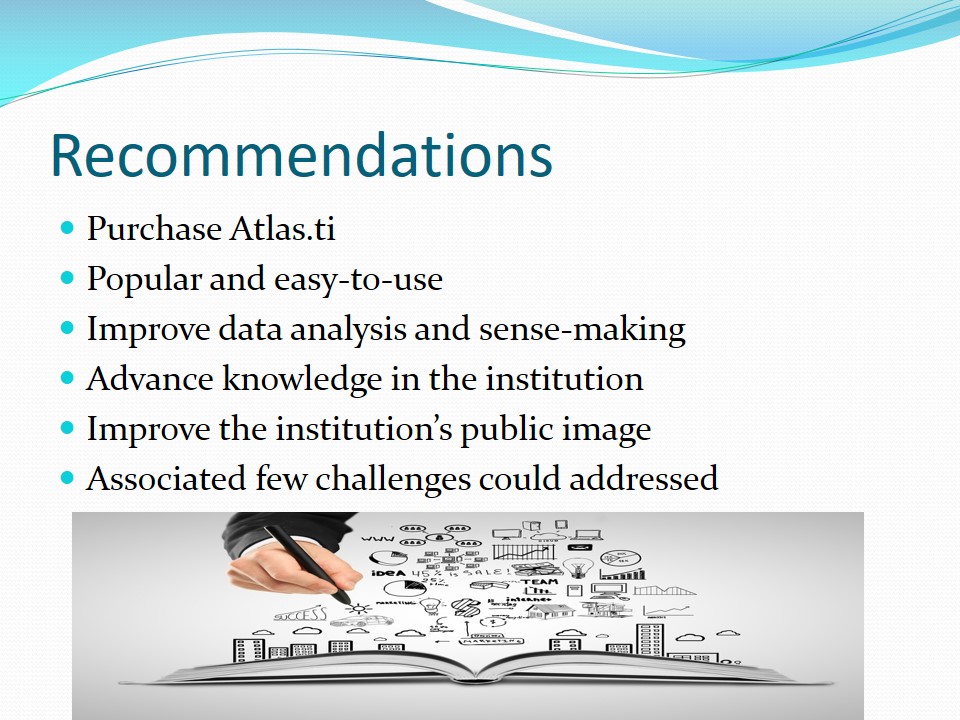
References
Maher, C., Hadfield, M., Hutchings, M., & de Eyto, A. (2018). Ensuring rigor in qualitative data analysis: A design research approach to coding combining NVivo with traditional material methods. International Journal of Qualitative Methods, 17, 1-13.
Rahman, M. S. (2016). The advantages and disadvantages of using qualitative and quantitative approaches and methods in language “testing and assessment” research: A literature review. Journal of Education and Learning, 6(1), 102-112.
Silver, C., & Lewins, A. (2014). Using software in qualitative research: A step-by-step guide (2nd ed.). Thousand Oaks, CA: Sage.
Sohn, B. K. (2017). Phenomenology and qualitative data analysis software (QDAS): A careful reconciliation. Qualitative Social Research, 18(1), 1-18.
Woods, M., Macklin, R., & Lewis, G. K. (2016). Researcher reflexivity: Exploring the impacts of CAQDAS use. International Journal of Social Research Methodology, 19(4), 385-403.